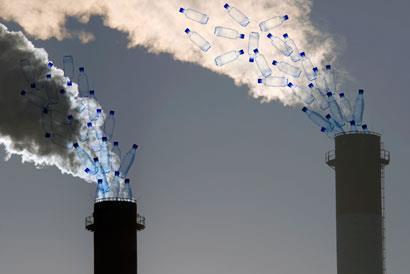
Researchers at the Energy Safety Research Institute (ESRI) at Swansea University have found a way of converting waste carbon dioxide into a molecule that forms the basis of making plastics
Researchers at the Energy Safety Research Institute (ESRI) at Swansea University have found a way of converting waste carbon dioxide into a molecule that forms the basis of making plastics. The potential of using global ethylene derived from carbon dioxide (CO2) is huge, utilising half a billion tonnes of the carbon emitted each year and offsetting global carbon emissions.
Dr Enrico Andreoli heads the CO2 utilisation group at ESRI. He said: “carbon dioxide is responsible for much of the damage caused to our environment. Considerable research focuses on capturing and storing harmful carbon dioxide emissions. But an alternative to expensive long-term storage is to use the captured CO2 as a resource to make useful materials.
That’s why at Swansea we have converted waste carbon dioxide into a molecule called ethylene. Ethylene is one of the most widely used molecules in the chemical industry and is the starting material in the manufacture of detergents, synthetic lubricants, and the vast majority of plastics like polyethylene, polystyrene, and polyvinyl chloride essential to modern society.”
Dr Andreoli said: “Currently, ethylene is produced at a very high temperature by steam from oils cracking. We need to find alternative ways of producing it before we run out of oil.”
The CO2 utilisation group uses CO2, water and green electricity to generate a sustainable ethylene at room temperature. Central to this process is a new catalyst – a material engineered to speed up the formation of ethylene. Dr Andreoli explained: “We have demonstrated that copper and a polyamide additive can be combined to make an excellent catalyst for CO2 utilisation. The polyamide doubles the efficiency of ethylene formation achieving one of the highest rates of conversion ever recorded in standard bicarbonate water solutions.”
The CO2 utilisation group worked in collaboration with the University of Nebraska-Lincoln and the European Synchrotron Research Facility in Grenoble in the formation of the catalyst.
Dr Andreoli concluded: “The potential of using CO2 for making everyday materials is huge, and would certainly benefit large-scale producers. We are now actively looking for industrial partners interested in helping take this globally-relevant, 21st century technology forward.”
Learn more: Swansea scientists discover greener way of making plastics
The Latest on: Waste carbon dioxide
[google_news title=”” keyword=”waste carbon dioxide” num_posts=”10″ blurb_length=”0″ show_thumb=”left”]
via Google News
The Latest on: Waste carbon dioxide
- Engineers create energy-smart, sustainable bricks from wasteon May 1, 2024 at 6:51 am
For manufacturers, that means saving up to 20 percent on firing temperatures by replacing clay with waste materials in brick production.
- Frontier bets $58.3M on carbon removal startup Vaulted Deepon May 1, 2024 at 4:59 am
Vaulted, which launched in September 2023, is a relative newcomer in the fast-growing field of carbon dioxide removal, though its core technology is already being deployed at commercial scale for ...
- Issues of the Environment: Happy Planet Running in Ann Arbor sprinting toward zero-waste running eventson May 1, 2024 at 3:27 am
Going out for a run is great exercise, and it also happens to be an eco-friendly activity. But what about when hundreds, or even thousands, run together? Competitive running draws big crowds, and big ...
- Enfinium unveils £1.7bn plan to install carbon capture at energy-from-waste siteson May 1, 2024 at 2:45 am
Firm touts plan to capture 1.2 million tonnes of carbon from the air annually by 2039, as it transitions to become a 'world leading carbon removals business' ...
- Sergey Brin-Backed Carbon Removal Startup Nears Firing Up Its New Planton April 29, 2024 at 3:00 am
Earth CEO John Pimentel will appear at Bloomberg Green Festival in July. In his first comments since taking over, he explains why he’s aiming for a moonshot.
- Waste not, want not: How methane biogases can help us reach our climate goalson April 28, 2024 at 5:00 am
How can the U.S. meet its 30×30 methane goal? Tapping America’s massive organic waste streams as a renewable energy resource.
- 5 New Ways of Making Good Use of Carbon Wasteon April 22, 2024 at 12:44 pm
From filling carbon dioxide into tanks packed with algae to capturing CO2 and creating limestone and chalk for construction, these new innovations will be crucial in our fight against climate change ...
- 3 carbon capture technologies you’ve probably never heard ofon April 22, 2024 at 11:47 am
From microalgae biorefineries and biomass burial to “blusinkies” — these novel technologies are paving the way to a net zero future.
- Race to zero wasteon April 22, 2024 at 5:53 am
UD has been part of the National Wildlife Federation’s Campus Race to Zero Waste competition, where scores of college campuses and several million students try to divert as much material away from ...
via Bing News










